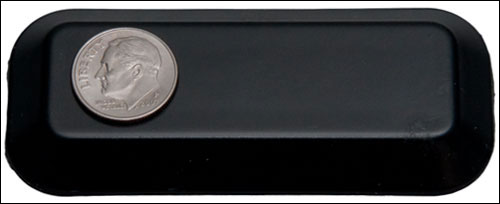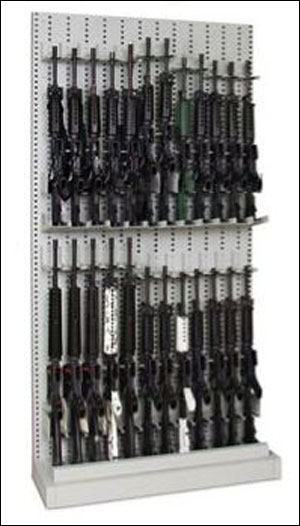Lockheed Martin’s Information Systems and Global Solutions (IS&GS) division has begun marketing a solution for government agencies that can detect the movement and, in some cases, condition and operation of weapons and ammunition. Lockheed Martin IS&GS is offering the solution, known as the RuBee Sensitive Item Warehouse system—manufactured and previously sold by Visible Assets Inc. (VAI)—for its customers at several U.S. and international government agencies. Lockheed Martin will provide installation, integration and enterprise-level management of the technology, as part of the company’s Global C4ISR portfolio of products. (C4ISR is a military term, derived from the words “Command, Control, Communications, Computers, Intelligence, Surveillance and Reconnaissance.”)
Lockheed Martin is currently in discussions with an armory that services the U.S. Department of Energy (DOE), to install the technology at that armory and thereby track the movements of weapons, with the goal of expanding the system to other armories throughout the DOE. Four DOE sites have been utilizing the RuBee-based weapons-tracking solution provided by VAI, including one deployed in Texas in 2011 (see Pantex Nuclear Weapons Plant Adopts RuBee RFID to Track Tools, Chemicals). Lockheed Martin is conducting a pilot for the U.S. Department of Defense (DOD), and expects to complete that deployment later this year, according to David Weber, Lockheed Martin IS&GS’ business-development manager for C4ISR. For the DOD deployment, Lockheed is serving as the prime contractor, with VAI acting as the subcontractor. The intention, Weber says, will be to expand the solution’s use, thereby managing the complete arsenal of weapons for the DOD customer, which has asked to remain unnamed.
The technology that Lockheed Martin is marketing complies with the RuBee standard (IEEE 1902.1). The company’s RuBee MIL STD 810G battery-powered tags are designed to be attached to weapons and receivers that capture an item’s ID number and forward that information to software. RuBee tags can be the technology of choice for munitions tracking by government agencies, Weber explains, since it transmits a 132 kHz low-frequency (LF) signal that relies primarily on the magnetic portion of an electromagnetic wave, rather than the electronic component. Such a signal, Lockheed Martin reports, operates well within metal and liquid environments, and is intrinsically safe near explosives and fused ordnances. What’s more, VAI adds, the very low frequency makes a RuBee transmission safer from eavesdropping and does not pose a target risk, since it will not leak out of a building.
The Allegro Armory 20/20 solution can also include steel smart racks installed with a RuBee reader and antennas as required for each specific customer and use case. The readers are powered by an Ethernet connection, with data related to those reads managed by VAI’s Dot-Tag Visibility Server software. When weapons or other items stored on the shelves are needed, staff members enter and exit the armory by scanning a bar code or a magnetic stripe on their ID badges (or, in some cases, workers carry RuBee tags). That badge ID is then linked to the ID number of the munitions that are detected to be removed.
For weapons, in most cases, tags are either incorporated into a standard grip or attached on a barrel. Tagging the weapons enables them to be identified not only by a smart rack, but also by a VAI pRap handheld reader or a RuBee DoorGuard or GateReader.
With the weapons shot counter (WSC) functionality, the technology also comes with an accelerometer linked to the munitions item’s tag. That sensor enables the system to track the number of times the weapon is used, and to determine the barrel temperature based on that data.
VAI has been improving its hardware, says John Stevens, the company’s CEO and chairman, and Lockheed Martin will offer the latest version of tags and readers—which can have a read range of 70 feet, and have been tested at a distance of 30 feet underground in optimal conditions (though in the munitions-tracking use case, the standards for safety around explosives result in a shorter read range). The company has been focusing on improving the technology’s performance within the military’s Hazards of Electromagnetic Radiation Ordnance (HERO) standards, and has accomplished a zero Safe Separation Distance (SSD) standard, signifying that the tag can safely be read on potentially explosive devices.
Lockheed Martin entered into conversations with VAI approximately two and a half years ago, Weber says, after Stevens had approached the aerospace and defense company, seeking its input regarding how cellular technology could be used with the RuBee system. After months of discussion, the companies decided to form a partnership in which Lockheed Martin will now sell and install the Visible Assets technology as the prime contractor, while VAI will serve as the subcontractor, providing hardware and software.
For the DOE, for example, VAI provides solutions for managing the locations of weapons at multiple armories. At this particular armory, weapons are stored for nuclear facility security guards. By installing the RuBee hardware and software, the armories are able to identify which item is located at that armory, as well as what is removed and by whom.
In addition, a division of the DOD is conducting a pilot of the Allegro 20/20 WSC at one of its sites. Lockheed Martin provided the VAI technology, and each time a weapon is fired, the software is updated with that data, providing officials with a record of that weapon’s operation and servicing. The system thereby enables them to know when a heavily used weapon is ready for servicing, while another that has been used less frequently may not be.
The partnership with Lockheed Martin will make the products more marketable, both VAI and Lockheed report, since Lockheed has the resources to sell and install solutions on a large scale. “Our business model has been to do the research and development,” Stevens states. “We supply those products, and licensing partners sell and install full system.” Lockheed Martin has unique engineering and market knowledge, Weber says, with the potential to drive large, enterprise-wide adoptions. VAI has had successful individual facility installations, he adds, but with Lockheed Martin, “The big picture is hundreds of warehouses integrated together.”




